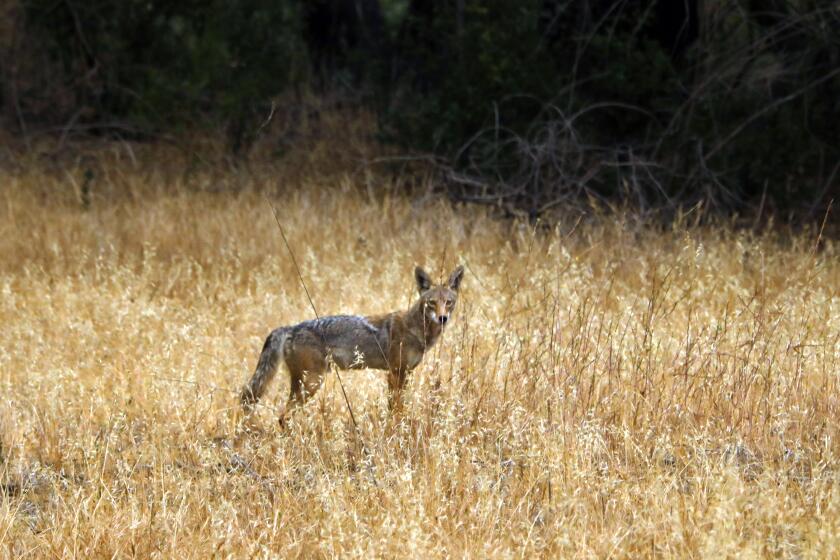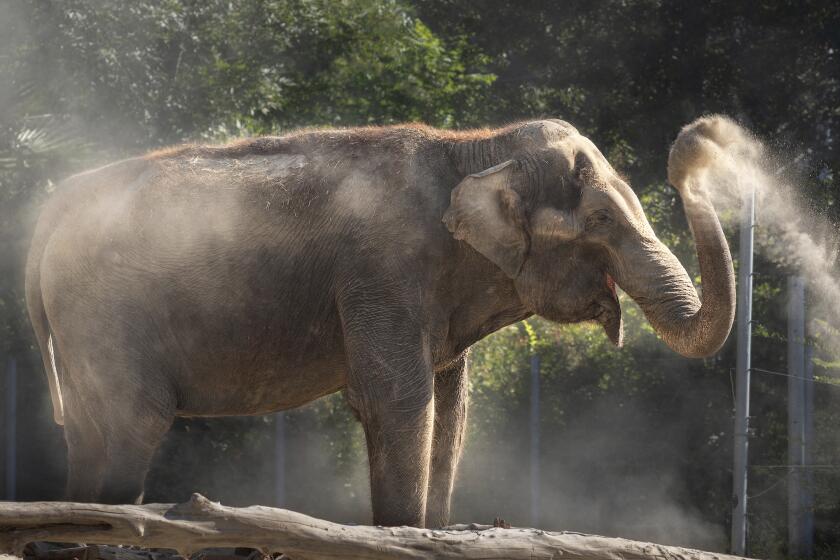Outdoor Notes : Drift Gill Nets Are Injuring and Killing Whales
The National Coalition for Marine Conservation says at least 20 whales are known to have become entangled in drift gill nets off the Southern California coast since 1980, and that many more may have been injured or killed by the nets.
“This may just be the tip of the iceberg,” said Carl Nettleton, the organization’s executive director. “We always assumed the problem with whale entanglements in gill nets was minimal. . . . We were surprised to find such a large number of continued sightings of entangled whales.”
Members of the NCMC became concerned after learning that a California gray whale became entangled in a net off Dana Point in January.
The figure of 20 known entanglements may be misleadingly low. The NCMC reports that the National Marine Fisheries Service believes many other whales become entangled, die and sink, unobserved.
In the 20 known cases, 12 whales died, and six of the 20 incidents occurred in the first two months of 1985.
The National Marine Fisheries Service is considering a proposal that would ban drift gill nets off the coast from Nov. 1 to Jan. 31, whale migration periods.
Twelve of the 20 entangled whales were grays and three others were humpback whales.
Because of a continuing drought in Canada’s prairie provinces, the U.S. Fish and Wildlife Service is considering hunting rules that would decrease next fall’s harvest of mallard and pintail ducks.
The USF&WS; says mallard-pintail numbers are at a 30-year low. The prolonged drought has affected the two species’ prime nesting areas in Canada. Federal biologists believe restrictive harvest regulations are advisable now, to help speed the recovery of duck numbers when nesting habitat conditions improve.
The Service may establish restrictive regulations in all four U.S. waterfowl flyways that would remain in effect for a predetermined length of time.
Jim Ellis of Gilbert, Ariz., was a much photographed fisherman recently. When he reported catching a 15-pound largemouth bass--a new Arizona record--at Canyon Lake, his picture appeared on outdoor pages throughout the state.
However, after several citizens had reported possible irregularities to Arizona’s Game & Fish Department, officers investigated. Result: Ellis admitted during questioning that he’d caught the fish with an unbeatable method--dynamite.
Citizen tips had it that someone was seen throwing sticks of dynamite into the lake the morning Ellis claimed to have caught the fish.
Arizona’s largemouth bass record remains 14-pounds 2-ounces, the size of one caught by Ed Smith of Phoenix, in 1956.
In 1981, ’82 and ‘83, Arizona biologists reintroduced about 45 river otters into suitable Verde River habitat. Little was known about the success of the transplants--the otters were from Louisiana--until Feb. 21, when an otter was killed on Highway 279.
According to biologists, the otter weighed 18 1/2 pounds, was healthy when killed and was carrying three near-term fetuses.
The annual Department of Fish and Game survey of Nelson bighorn sheep in the San Gabriel Mountains resulted in an estimate of 600 to 700 animals.
DFG biologist Marti Pletcher said that 380 to 400 bighorns were sighted during the count March 16-17 by 95 volunteers, some of whom hiked nine miles to lookout positions. The count was adjusted to 600-700 to account for an error margin.
Pletcher said that the San Gabriels population is probably at its peak and not expected to grow because of a lack of suitable habitat. She said the estimated lamb-ewe ratio was a healthy 25-to-100 and that all the animals seemed to be in good condition, with abundant green forage available.
Some of the volunteer counters were members of the Society for the Conservation of Bighorn Sheep. DFG bighorn authority Dick Weaver said there are roughly 4,300 bighorns in California, divided into three types: Nelson (3,100), California (300) and peninsular (900). The San Gabriels are home to more bighorns than any other range in the state.
Briefly The U.S. Canoe Association’s National Marathon Canoe and Kayak Championships will be held Aug. 15-18 at Lafayette, Ind. . . . Utah fisheries biologist Wayne Gustaveson says Lake Powell fishermen can expect the “best fishing conditions since 1981 this spring,” because of an abundant population of threadfin shad and a high water nutrient level. . . . Showtime: Newport In-The-Water Boat Show, Lido Marina Village, April 11-14 (used boats), April 17-21 (sailboats), April 24-28 (power boats); Anaheim Boat Show, April 10-14, Anaheim Convention Center. . . . The National Shooting Sports Foundation points out that since 1939, hunters have contributed more than $1 billion in excise tax funds for wildlife restoration programs. . . . The Balboa Angling Club has invited 80 youngsters from Los Angeles and Orange counties on a free fishing trip out of Davy’s Locker, Newport Beach, June 20. . . . The DFG reminds grunion lovers that April and May are hands-off months for the silvery little fish. It’s illegal to take the fish during their beach spawning runs in those months. Grunion may be taken again--by hand only--on runs beginning June 4.
More to Read
Start your day right
Sign up for Essential California for news, features and recommendations from the L.A. Times and beyond in your inbox six days a week.
You may occasionally receive promotional content from the Los Angeles Times.






